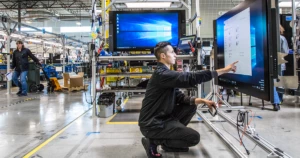
Federal Science and Research Summit 2020: democratizing tech for the public good
For two days in October, a group of leaders from federal agencies, industry, and academia gathered to share their progress in leveraging technology for the health of the planet. I think everyone who attended the Microsoft Federal Science and Research Summit felt fortunate to have a front row seat for these discussions, which were both informative and inspiring. For those who weren’t able to join us live, content is now available on demand.
The power of technology partnerships
The summit opened with a fireside chat between Eric Horvitz, Technical Fellow and Chief Scientific Officer at Microsoft, and Cheryl Ingstad, Director of the AI and Technology Office at the U.S. Department of Energy. Together they touched on the use of data, AI, high performance computing (HPC), 5G, and edge computing in research. They also explored the value of public-private partnerships, as government, commercial, and academic organizations combine their skills and resources to further the scientific realm.
Ingstad gave insight into how the scientific and academic community wants to partner with technology experts: “One of the things we’ve heard is that scientists really want to work in the area of their specialty, but they don’t want to become AI experts to utilize these tools or to manage the data. So how do we get data managers and AI experts to the operational and research levels to support our scientists that way?”
Throughout the summit, we heard many examples of how organizations are working to democratize AI and make these technologies more accessible and usable for scientists.
Promoting the progress of science
The session, “Utilizing Synthetic Data to Train Models,” featured panelists from the Washington University School of Medicine in St. Louis, Azure Mixed Reality, and the Pacific Northwest National Laboratories. They talked about new techniques for generating synthetic data that are helping to accelerate machine learning, reduce implicit biases, and compensate for the lack of adequate data.
Jon O’Neil, Director of the Big Data Program at the National Oceanic and Atmospheric Administration (NOAA), spoke about “Driving Innovation with Public-Private Partnerships.” NOAA has worked with multiple cloud providers to upload 5.5 petabytes of NOAA data so that it is accessible, secure, and useful to the public. Anyone can work with the Azure Open Datasets, which include global forecast data and hourly weather history from NOAA.
The next session, “How Can AI Drive Environmental Sustainability?”, included participants from NASA Jet Propulsion Laboratory, NOAA’s Research, Informatics, and Visualization Branch, the North Carolina Institute for Climate Studies, the Center for Spatial Ecology and Restoration at Florida A&M and U.S. Forest Service, and Microsoft AI for Earth.
The conversation explored how AI and HPC are enabling researchers across the public and private sectors to better understand and address the planet’s sustainability challenges.
Finally, John Turner, Computational Engineering Program Director at Oakridge National Laboratory, addressed “Leveraging Cloud for High Performance Computing.” Turner gave several examples of running machine learning on cloud platforms for research on wind farms and interactive wakes, dendritic solidification for metal additive manufacturing, and energy storage.
Hope for ensuring the future of our planet
During the fireside chat that opened the summit, I was struck by a story that Horvitz shared about Harvard biologist E.O. Wilson. The two men had just attended a seminar on AI and the environment. Wilson walked out shaking his head and told Horvitz that he believed AI methods might be the only hope we have for ensuring the flourishing of life on the planet going forward, given the environmental challenges we face.
Wilson’s comment captures both the promise and the urgency that characterized this first Microsoft Federal Research and Science Summit. I look forward to seeing what new partnerships emerge from the connections and ideas explored.
If you are interested in understanding AI and related technologies better, Microsoft Learn has a number of accessible training and demo opportunities. The Cloud Skills Challenge features learning paths on data and AI solutions.




